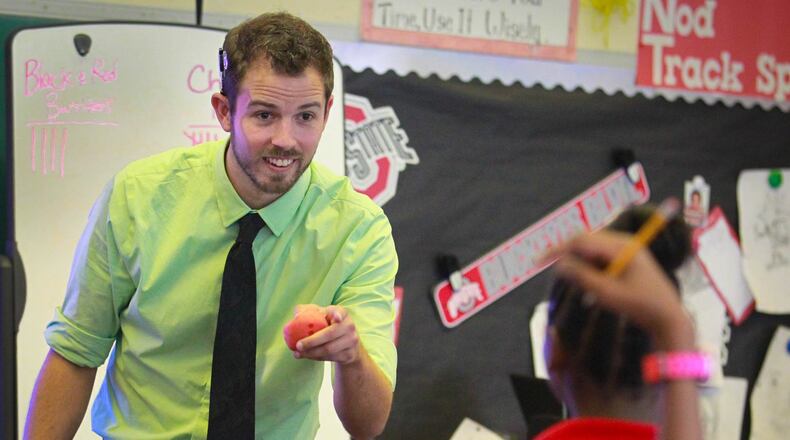Charter schools — also called community schools - got letter grades in up to nine specific areas based on student performance in 2012-13, just as public schools. New value-added measures, on the report cards released in August, show whether students made sufficient academic progress in one year’s time and the Annual Measurable Objectives (AMOs) tell how each subgroup of students narrowed achievement gaps with the student body as a whole.
Overall grades — summing up a school’s entire performance — won’t come until 2015 on the new A-F report cards, which will replace the previous six-tier system that rated schools from “Excellent with Distinction” down to “Academic Emergency.”
A Dayton Daily News examination of local charter school data found some excelled in the Performance Index category which measures total test performance - from basic to advanced — but struggled in the "value-added" categories. Other schools where students failed to achieve 75 percent proficiency on any state test scored an "A" on a value-added measure, because of the progress that certain groups of (disabled/gifted) students made.
While the A-F system is easier for the public to understand, when grades for Performance Index and Value Added are at opposite ends of the scale, it sends a mixed messages to parents, Churchill said.
“Performance indicators are where the rubber meets the road. Are kids on track to meet academic standards set by the state, ” Churchill said. “Parents are going to want to know if their child is on track for college.”
Marianne Lombardo, vice president, research and accountability for the Ohio Alliance for Public Charter Schools, said charter schools definitely have areas of strength around the state and Dayton is one of them.
Of the top six schools in Dayton ranked by Performance Index scores, four are charter schools. Stivers School for the Arts (public school) ranked first, followed by the Dayton Early College Academy, Pathway School of Discovery, Emerson Academy, Charity Adams Early Girls Academy (public school) and DECA Prep.
The Dayton Early College Academy — grades seven to 12 — earned a Performance Index of “B” the highest grade of any charter school in the region. The school focused on preparing first-generation urban students for college, got a letter grade of “F” on the AMO.
“It’s illuminating. The bad portion is frustrating and discouraging, beyond that there’s a feeling that we can do this,” David Taylor, principal of Dayton Early College Academy said. “What the report card gives us is a launching pad for where we need to go for continuous improvement.”
During the 2012-13 school year, 99,040 students attended one of Ohio’s 282 charter schools, which is about 6 percent of the total public school enrollment. Five schools got an “A” on the Performance Index category, 14 got an “F” and 152, including most in Montgomery County, got a “D.”
There are consequences for charter schools that fail to make the grade over time. A charter school may be closed by the state if it earns an academic emergency rating and a red (or F) rating in the value added category in two of the last three years.
In Montgomery County, 6,132 students attended 21 community schools. One is in Trotwood and another in West Carrollton. The rest are located in the city of Dayton.
Judy Hennessey, superintendent of the Dayton Early College Academy and principal of DECA Prep, said about 48 percent of the school’s incoming sixth graders were behind grade level in reading and math, when the school opened last August.
The school met the benchmark for sixth grade reading after an intense year of Saturday school, but missed the mark in math. The school got a “D” on its performance index.
“The bottom line is, we had a very short window to work,” Hennessey said. “We didn’t expect to perform miracles.”
Hennessey said Saturday school will be available to younger students beginning in October.
“You can’t be a great school unless all of your students are succeeding,” she said.
Emerson Academy of Dayton received an effective rating from the Ohio Department of Education on its 2011-2012 report card, which fell in the middle of the state’s former six-tier system. The school got a “C” on its performance index on the new report card, meeting six of 15 performance standards.
“My initial thought was, how did we fall so far after doing so well,” Ron Albino, principal of Emerson Academy, said. “The bar has been raised. We have to work harder.”
Emerson, the Horizon Science Academy Dayton (downtown), and the Dayton Leadership Academies-Dayton Liberty Campus, all earned an “A” for overall value added.
“Our students are progressing faster than the state average,” Albino said. “That reflects the progress our teachers and students are making overall.”
The Summit Academy Community School for Alternative Learners, with 144 students, is the only charter school in Greene County. Mark Sebastian, principal of the school in Xenia, called the new rating system an improvement. At least 85 percent of his school’s up to 175 students have learning disabilities and take part in an Individualized Education Program (IEP).
“I’m not saying the report cards is perfect, but it’s an improvement over last year. It shows we’re doing a good job with the student population we serve,” Sebastian said. “In year’s past, the only indicator we met was for attendance.”
About the Author
